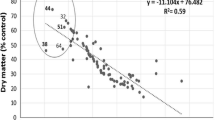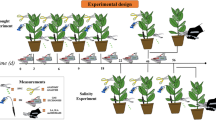Abstract
Two populations of cogongrass [Imperata cylindrica (L.) Raeuschel], one from the saline regions of the Salt Range and the other from the non-saline regions of Faisalabad were assessed for salinity tolerance on the basis of some key morphological and physiological attributes. It was hypothesized that the tolerant population from the Salt Range must have developed some specific structural modifications, which are responsible for its better survival under high salinities. These adaptive components can be effectively used in modern technologies for improving degree of tolerance of other sensitive crops. The population from the Salt Range markedly excelled the Faisalabad population in terms of growth and physiological attributes measured in this study. The Faisalabad population of I. cylindrica was unable to survive at the highest salt level (200 mM NaCl). The tolerance of the Salt Range population to salt stress was found to be related to high accumulation of organic osmotica, particularly total free amino acids and proline as well as Ca2+ in the shoot. The distinctive structural modifications in the Salt Range population were found to be enhanced succulence, well-developed bulliform cells in leaves and smaller stomatal area.
Similar content being viewed by others
References
Abdel C.G. & Al-Rawi I.M.T. 2011. Anatomical alteration in response to irrigation and water stress in some legume crops. Am. J. Exp. Agri. 1: 231–264.
Ahmad F., Hameed M., Ashraf M., Ahmad M., Khan A., Nawaz T., Ahmad K.S. & Zafar M. 2012. Role of leaf epidermis in identification and differentiation of grasses in tribe Chlorideae (Poaceae) from Pakistan. J. Med. Plant Res. 6: 1955–1960.
Alshammary S.F., Qian Y.L. & Wallner S.J. 2004. Growth response of four turfgrass species to salinity. Agric. Water Manag. 66: 97–111.
Arnon D.I. 1949. Copper enzymes in isolated chloroplasts: polyphenoloxidase in Beta vulgaris. Plant Physiol. 24: 1–15.
Ashraf M. & Harris P.J.C. 2004. Potential biochemical indicators of salinity tolerance in plants. Plant Sci. 166: 3–16.
Ashraf M. & O’Leary J.W. 1996. Responses of some newly developed salt-tolerant genotypes of spring wheat to salt stress: Yield components and ion distribution. J. Agron. Crop Sci. 176: 91–101.
Ashraf M. McNeilly T. & Bradshaw A.D. 1986. The response of selected salt-tolerant and normal lines of four grass species to NaCl in sand culture. New Phytol. 104: 453–461.
Ashraf M., Mcneilly T. & Bradshaw A.D. 1989. The potential for evolution of tolerance to NaCl, CaCl2, MgCl2 and sea water in four grass species. New Phytol. 112: 245–254.
Ashraf M., Akhtar Y.K. & Sarwar G. 2002. Evaluation of arid and semi-arid ecotypes of guar (Cyamopsis tetragonoloba L.) for salinity (NaCl) tolerance. J. Arid Environ. 52: 473–482.
Ashraf M. 1994. Breeding for salinity tolerance in plants. Crit. Rev. Plant Sci. 13: 17–42.
Ashraf M. 2004. Some important physiological selection criteria for salt tolerance in plants. Flora 199: 361–376.
Balsamo R.A., Willigen C.V., Bauer A.M. & Farrant J. 2006. Drought tolerance of selected Eragrostis species correlates with leaf tensile properties. Ann. Bot. 97: 985–991.
Bates L.S., Waldren R.P. & Teare I.D. 1973. Rapid determination of proline for water stress studies. Plant Soil 39: 205–207.
Bohnert H.J. & Jensen R.G. 1996. Strategies for engineering water stress tolerance in plants. Trends Biotech. 14: 89–97.
Chaparzadeh N., Khavari-Nejad R.A. & Navari-Izzo F. 2003. Water relations and ionic balance in Calendula officinalis L. under salinity conditions. Agrochimica 47: 69–79.
Chaudhary S.A. 1989. Grasses of Saudi Arabia, National Herbarium, National Agriculture and Water Research Center, Ministry of Agriculture and Water, Riadh, Kingdom of Saudi Arabia.
Chaudhry A.A., Hameed M. & Ahamd R. 2001. Phyto-sociological studies in Chhumbi Surla Wildlife Sanctuary, Chakwal, Pakistan. I. Species diversity. Int. J. Agri. Biol. 3: 363–368.
Cope T.A. 1982. Poaceae. In: Nasir E. & Ali S.I. (eds), Flora of Pakistan, University of Karachi, Karachi, Pakistan.
Flowers T.J. & Colmer T.D. 2008. Salinity tolerance in halophytes. New Phytol. 179: 945–963.
Gulzar S., Khan M.A. & Ungar I.A. 2003. Effects of salinity on growth, ionic content, and plant-water status of Aeluropus lagopoides. Comm. Soil. Sci. Plant Anal. 34: 1657–1668.
Hameed M. & Ashraf M. 2008. Physiological and biochemical adaptations of Cynodon dactylon (L.) Pers. from the Salt Range (Pakistan) to salinity stress. Flora 203: 683–694.
Hameed M., Naz N., Ahmad M.S.A., Islam-ud-Din Shazad & Riaz A. 2008. Morphological adaptations of some grasses from the Salt Range, Pakistan. Pak. J. Bot. 40: 1571–1578.
Hameed M., Ashraf M. & Naz N. 2009. Anatomical adaptations to salinity in cogon grass [Imperata cylindrica (L.) Raeuschel] from the Salt Range, Pakistan. Plant Soil 322: 229–238.
Hameed M., Ashraf M., Naz N. & F. Al-Qurainy. 2010. Anatomical adaptations of Cynodon dactylon (L.) Pers. from the Salt Range Pakistan to salinity stress. I. Root and stem anatomy. Pak. J. Bot. 42: 279–289.
Hameed M., Ashraf M. & Naz N. 2011. Anatomical and physiological characteristics relating to ionic relations in some salt tolerant grasses from the Salt Range, Pakistan. Acta Physiol. Plant. 33: 1399–1409.
Hameed M., Ashraf M., Naz N., Nawaz T., Batool R., Ahmad M.S.A, Ahmad F. & Hussain M. 2013. Anatomical adaptations of Cynodon dactylon (L.) Pers. from the Salt Range (Pakistan) to salinity stress. II. Leaf anatomy. Pak. J. Bot. 45(S1): (in press).
Hernandez J.A. & Almansa M.S. 2002. Short-term effects of salt stress on antioxidant systems and leaf water relations of pea leaves. Physiol. Plant. 115: 251–257.
Lacerda C.F., Cambraia J. & Oliva M.A. 2003. Solute accumulation and distribution during shoot and leaf development in two sorghum genotypes under salt stress. Environ. Exp. Bot. 49: 107–120.
Mahmood S. & Athar H.R. 2003. Germination and growth of Panicum turgidum provenance under saline conditions. Pak. J. Biol. Sci. 6: 164–166.
Matumura M. & Nakajima N. 1988. Comparative ecology of intraspecific variants of the Chigaya, Imperata cylindrica var. koenigii (Alang-alang). III. Annual growth of the 3rd year communities originated from the seedlings. J. Jap. Soc. Grassland Sci. 34: 77–84.
McKerrow W.S. Scotese C.R. & Brasier M.D. 1992. Early Cambrian continental reconstructions. J. Geol. Soc. 149: 599–606.
Moor S. & Stein W.H. 1948. Photometric ninhydrin method for use in the chromatography of amino acids. J. Biol. Chem. 176: 367–388.
Munns R. 2002. Comparative physiology of salt and water stress. Plant Cell Environ. 25: 239–250.
Munns R. 2011. Plant adaptations to salt and water stress: Differences and commonalities. Adv. Bot. Res. 57: 1–32.
Nawaz T., Hameed M., Ashraf M., Ahmad F., Ahmad M.S.A., Hussain M., Ahmad I., Younis A. & Ahmad K.S. 2012. Diversity and conservation status of economically important flora of the Salt Range, Pakistan. Pak. J. Bot. 44: 203–211.
Naz N., Hameed M., Ashraf M., Al-Qurainy F. & Arshad M. 2010. Relationships between gas-exchange characteristics and stomatal structural modifications in some desert grasses under high salinity. Photosynthetica 48: 446–456.
Netondo G.W., Onyangoa J.C. & Beck E. 2004. Sorghum and salinity. I. Response of growth, water relations, and ion accumulation to NaCl salinity. Crop Sci. 44: 797–805.
Qadir M., Noble A.D. & Oster J.D. 2005. Driving forces for sodium removal during phytoremediation of calcareous sodic soils. Soil Use Manag. 21: 173–180.
Qian Y.S., Wilhelm J. & Marcum K.B. 2001. Comparative responses of two Kentucky bluegrass cultivars to salinity stress. Crop Sci. 41: 1895–1900.
Rozema J., Pephagen I. & Sminia T. 1977. A light and electron microscopical study on the structure and function of salt gland of Glaux maritima L. New Phytol. 79: 665–671.
Santoso D., Adiningsih S. & Mutert E. 1997. Soil fertilitymanagement for reclamation of Imperatai grasslands by smallholder agroforestry. Agroforest System 36: 181–202.
Steel R.G.D., Torrie J.H. & Dickey D.A. 1997. Principles and Procedure of Statistics: A Biometrical Approach. McGraw Hill.
Streeter J.G., Lohnes D.G. & Fioritto R.J. 2001. Patterns of pinitol accumulation in soybean plants and relationships to drought tolerance. Plant Cell Environ. 24: 429–438.
Taji T., Ohsumi C. & Iuchi S. 2002. Important roles of drought and cold inducible genes for galactinol synthase in stress tolerance in Arabidopsis thaliana. Plant J. 29: 417–426.
Wolf B. 1982. An improved universal extracting solution and its use for diagnosing soil fertility. Comm. Soil Sci. Plant Anal. 13: 1005–1033.
Yiotis C., Manetas Y. & Psaras G.K. 2006. Leaf and stem anatomy of the drought deciduous mediterranean shrub Calicotome villosa (Poiret) link. (Leguminosae). Flora 210: 102–107.
Yoshiba Y., Kiyosue T. & Nakashima K. 1997. Regulation of levels of proline as an osmolyte in plants under water stress. Plant Cell Physiol. 38: 1095–1102.
Author information
Authors and Affiliations
Corresponding author
Rights and permissions
About this article
Cite this article
Hameed, M., Ashraf, M., Naz, N. et al. Physiological adaptative characteristics of Imperata cylindrica for salinity tolerance. Biologia 69, 1148–1156 (2014). https://doi.org/10.2478/s11756-014-0417-1
Received:
Accepted:
Published:
Issue Date:
DOI: https://doi.org/10.2478/s11756-014-0417-1




